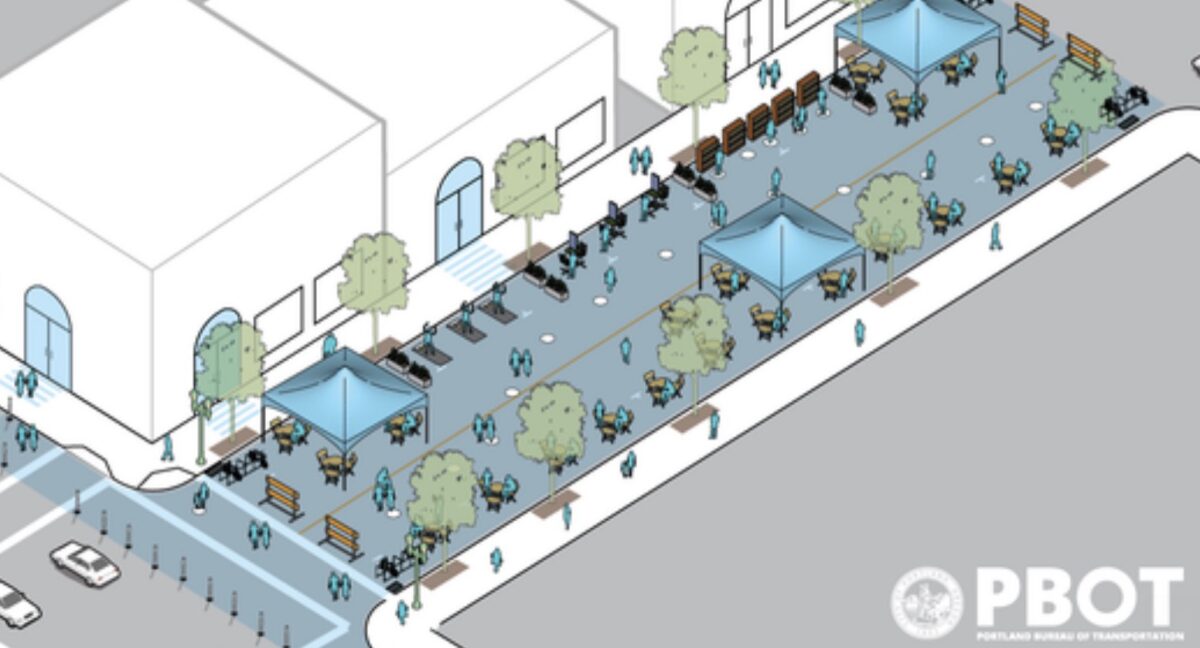
“An opportunity to build the future we want: A future with less people relying on private cars is essential to meeting PBOT’s strategic plan goals.”
— From new Safe Streets strategic plan
As we hinted at last week, the Portland Bureau of Transportation has just launched a new piece of their Safe Streets initiative that focuses on businesses. PBOT has also announced a related, $50,000 grant program for organizations to work with frontline communities.
PBOT has opened a permit application process and released a, “strategic framework for adapting streets as city restarts public life.” Both efforts aim to re-ignite safe business activity by utilizing public space traditionally used as parking lots and transportation corridors.
PBOT Commissioner said the effort will “reimagine public space.”
Business owners can apply online for a free Healthy Business permit which will give them the authority to use sidewalks and streets for a number of uses including: hygiene stations, product displays, queuing space for people or vehicles, tables and chairs for dining, waiting areas, temporary patios or plazas, or any other service or creative idea.
On some dense commercial corridors where demand is highest, PBOT says they will allow entire streets to become carfree public plazas.
Advertisement
In their announcement today they describe three possible plaza types: neighborhood plaza, mini neighborhood plaza, and full main street closure.
Neighborhood Plaza: use of parking spaces with side street partially closed for part of the block.
Mini neighborhood plaza: use of parking spaces with side street partially closed for part of a block.
Full main street closure*: PBOT will not allow full street closures on emergency routes or transit routes.
(*I really don’t understand why PBOT continues to use the word “close”. These streets are not being closed! They are being opened up to more uses than ever.)
PBOT says they won’t supply equipment to demarcate the in-street commercial spaces and they won’t be responsible for maintaining them. This means private businesses will have considerable sway over public spaces. This will be something to watch closely. PBOT says staff that oversees the permit program will, “balance needs of businesses with traffic safety, pedestrian access, public transit, and emergency response needs.”
At this point, the permits will be considered temporary and valid through October 1st.
This new permitting program comes at the same time PBOT is proposing protected bike lanes on Hawthorne Boulevard and is supporting the work of Portlander Zach Katz to create a series of Portland Promenades. Katz is focusing his efforts on carfree plazas on 28th Avenue and Belmont.
Advertisement
$50,000 in grants for “frontline community members”
“This partnership will prioritize organizations working in direct service to or in collaboration with Black, Indigenous and People of Color.”
In tandem with today’s announcement PBOT has invited community organizations to apply for grants and become part of a new Frontline Communities Partnership. “PBOT wants to ensure that the Safe Streets Initiative and all PBOT COVID-19 response efforts account for and support the needs of frontline community members,” says the program website.
Calling it a “partnership opportunity” PBOT has set aside $50,000 that will go to 5-10 organizations that will help advise the agency and take part in structured engagement events between June and October. The grants of up to $10,000 per organization will pay the groups to lead activities that, “Identify community needs to shape and inform how the Safe Streets program and other COVID-19 response efforts can work to meet those needs.”
“This partnership will prioritize organizations working in direct service to or in collaboration with Black, Indigenous and People of Color; Immigrants and Refugees; older adults and people living with disabilities and other populations at highest risk to COVID-19 or the compounding effects of the public health pandemic,” PBOT says.
New plan lays out strategic framework
“As we rally to meet the needs of today we owe it to ourselves to make sure our actions also support our city’s vision of the future.”
PBOT is not letting this opportunity to re-imagine streets go to waste. They’ve released a 30-page plan (PDF) that lays out their Safe Streets approach. “PBOT is carefully considering how transportation behavior has changed and how it needs to change, not just as we recover from this crisis, but to support a sustainable future,” reads a quote from Commissioner Eudaly in the plan’s introduction.
The plan offers a detailed overview of all the actions PBOT has taken thus far and it includes hints at several notable new measures.
To fill gaps in the Slow Streets network, PBOT says they will work with advocates in southwest, southeast (Brentwood-Darlington specifically) and east Portland.
In a section about “supporting community building, social connections, and the rethinking of travel choices” PBOT says they’ll deploy “traffic playgrounds” through their Safe Routes to School program to help families learn the rules of the road.
This plan makes it clear that PBOT is looking into the future well beyond the Covid-19 crisis. “This challenge offers the chance to step back and reevaluate our transportation habits and investment priorities,” it says. Here’s more from the final page of the plan:
“Looking to cities around the world that are further along the curve in Portland we are seeing notable Trends and shifts in transportation Behavior as governments begin to open up society again. Every time we ask Portlanders, they tell us they want a low-carbon, equitable transportation system. They want quiet neighborhood streets reliable and rapid transit, safe bicycling conditions and more reliable vehicle travel.
As we rally to meet the needs of today we owe it to ourselves to make sure our actions also support our city’s vision of the future. A future with less people relying on private cars is essential to meeting PBOT strategic plan goals of managing our transportation assets, providing sustainable mobility choices, and eliminating serious injuries and deaths from our roadways. All of this means a more resilient better connected and equitable future for Portland.”
— Jonathan Maus: (503) 706-8804, @jonathan_maus on Twitter and jonathan@bikeportland.org
— Get our headlines delivered to your inbox.
— Support this independent community media outlet with a one-time contribution or monthly subscription.

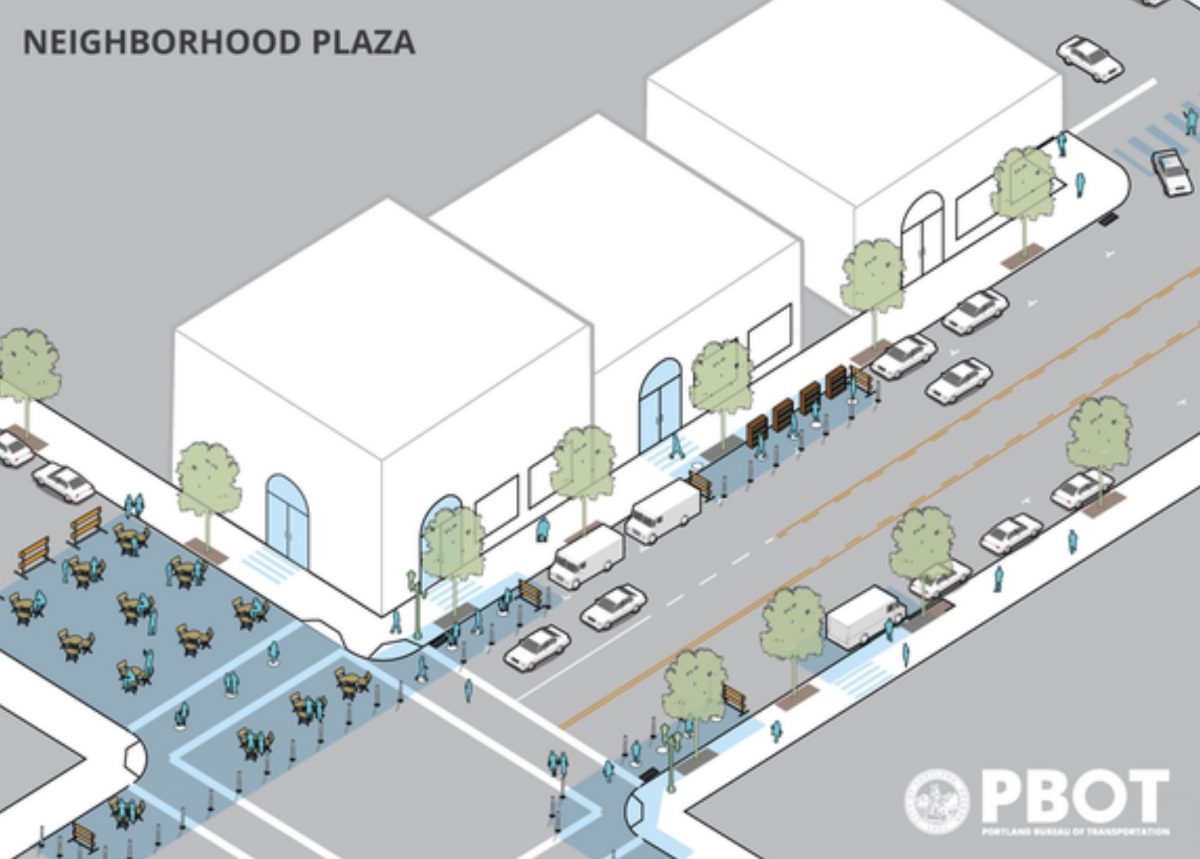

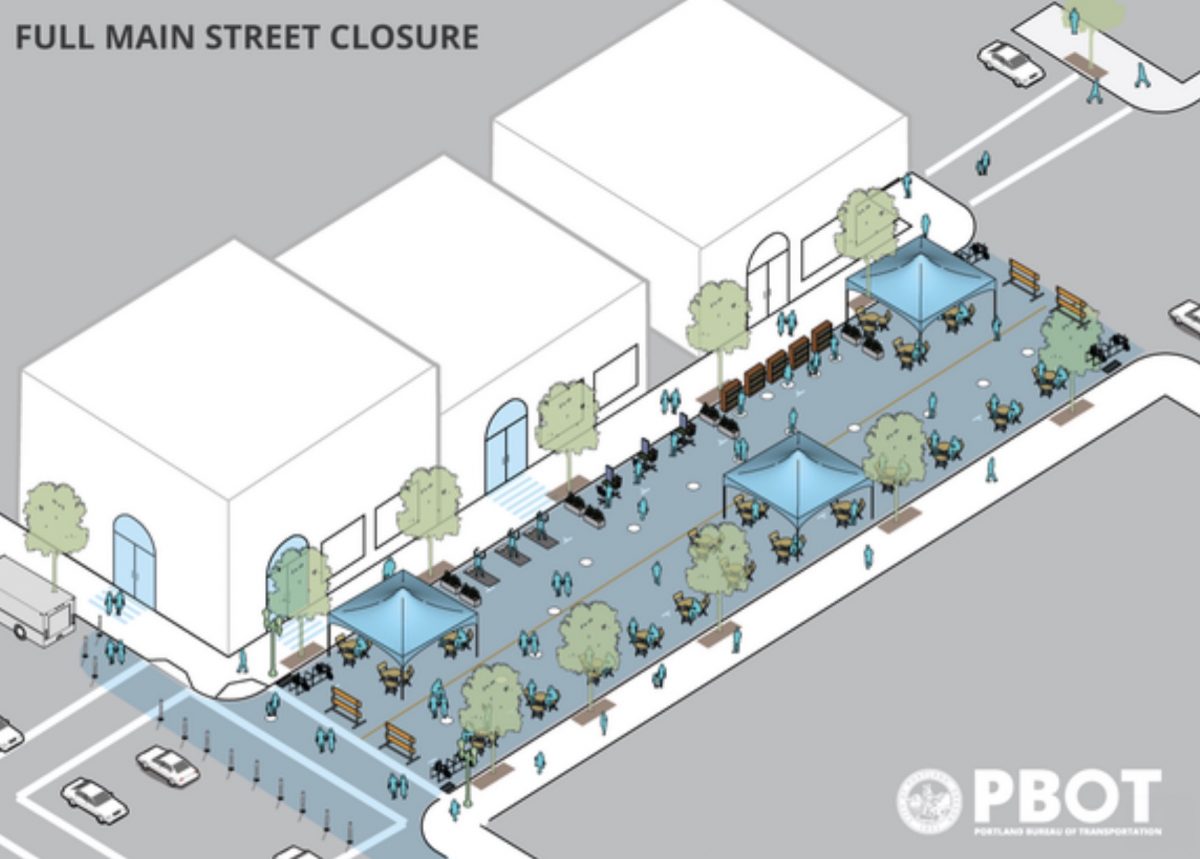

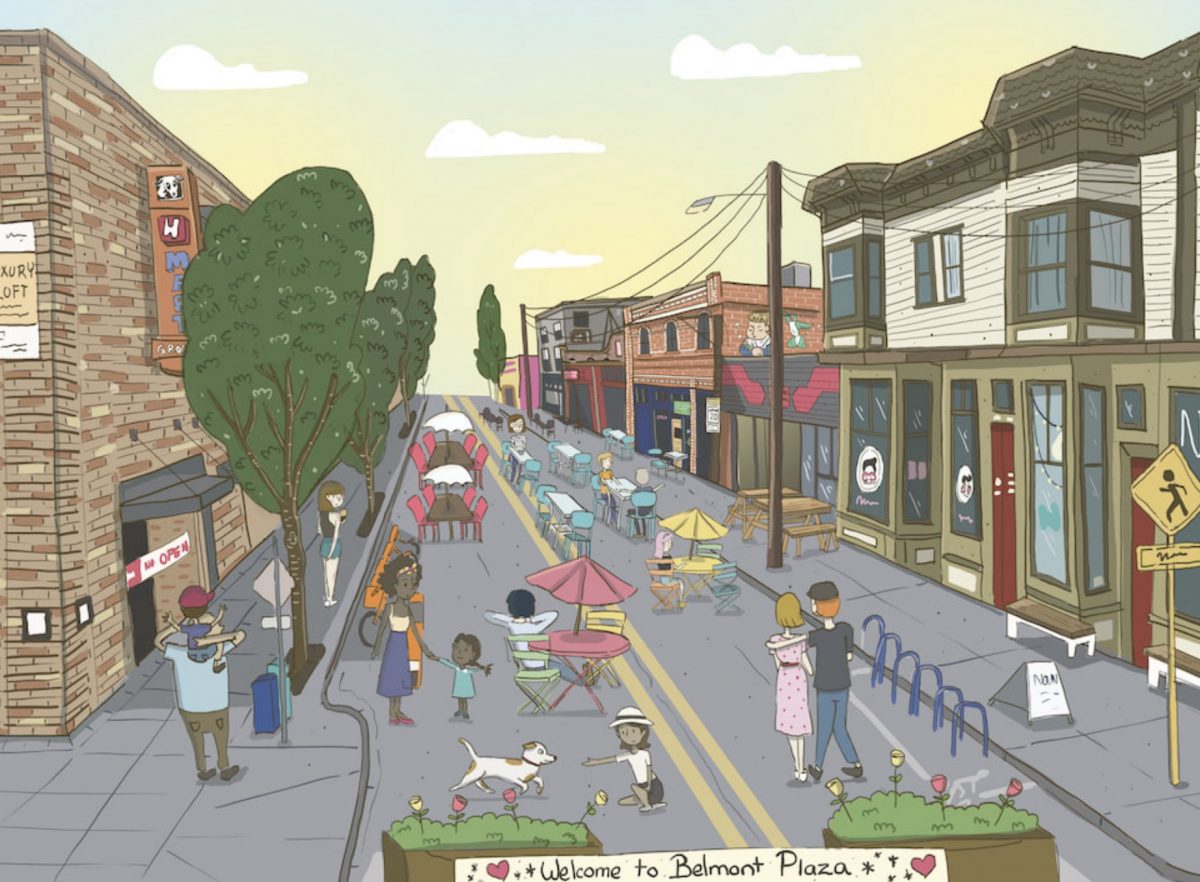
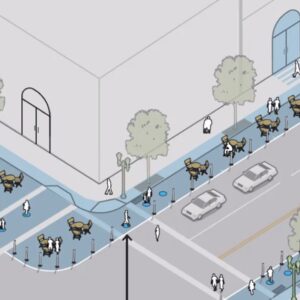
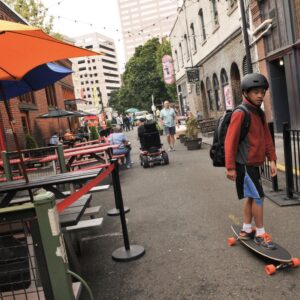
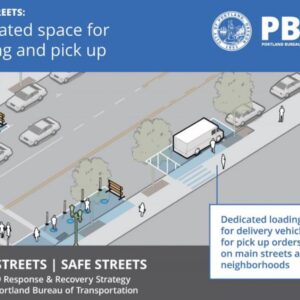
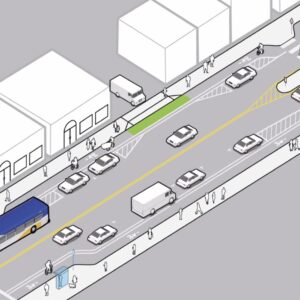
Thanks for reading.
BikePortland has served this community with independent community journalism since 2005. We rely on subscriptions from readers like you to survive. Your financial support is vital in keeping this valuable resource alive and well.
Please subscribe today to strengthen and expand our work.
Anything other than the Full Main Street Closure would be a non-starter for me. I can’t imagine sitting down to eat while cars and huge pickups drove next to me.
Or buses. Time to go electric, TriMet!
At roughly $750,000 per bus, that would only be about half a billion dollars. I-5 Rose Quarter project alternative?
I think the Neighborhood Plaza has potential actually. I wonder what size limitation there is for the amount of space that can be used?
Based on the amount of times someone has “rolled coal” at me while I’m riding,I can only imagine the amount of people with train horns and belching exhaust on people just for funsies.
We can re-create that European outdoor cafe culture, complete with that diesel exhaust smell mixed with cheap cigarettes, the noise of mopeds (or in Portland’s case overpowered electric bikes and scooters), snooty waiters, professional beggars, passing loud car stereos, the odd jackhammer here and there, and the wailing sirens of the police and EMT. What am I missing?
I asked a business owner on Foster if he thought about having extra seating instead of parking. He was supportive then said something like, “But those cars are going too fast for it.” This is yet another reason why the standard bike lanes on Foster are close to worthless. If there were protected bike lanes on Foster, Street seats or neighborhood plazas would be a no brainer.
Before I left Portland in 2015, I had a pleasant casual conversation with one of the city staff who was working on the Foster streetscape project. The person agreed at that time that what they should do (or have done) was put in protected bike lanes, street seats, etc. The city had enough money to do it, according to the person I was talking with, but the reason they chose not to do it was not because local businesses objected to it, but because the city gets more money from grants by doing projects in phases. The city expects that eventually the public will demand better facilities and PBOT will apply for more grants to do so at that later date. We both agreed that it was a convoluted way of doing business that served no public good whatsoever, but that it was symptomatic of PBOTs problems and a lot of other DOTs too.
Now with vastly reduced budgets and unbelievably high unemployment, PBOT has to justify to both the public and to city council why it has so much staff and yet has so little to build.
Wow David thanks. I can understand the long-term phased planning viewpoint. But I also don’t really see the urgency that I would expect if a DOT really had a commitment to physical separation. My impression is PBOT thinks greenways are enough. PBOT does not appear to see the use of actual practical separated infrastructure on main roads. SW and NE Broadway are both a fantastic example of this. There has been a clear need, and no action. Greenways are great to AUGMENT an existing network of protected bike lanes, not stand in their place. If biking is not practical and safe, people will continue to drive.
PBOT, not unlike other DOTs nationwide, has several dilemmas it needs to resolve:
– They have a strong ethical commitment to making their streets (as opposed to ODOT’s) as safe as possible, not only for social distancing, but also for Vision Zero, crash reduction, etc.
– They are also extremely dependent on a budget that requires everyone to drive gas guzzling cars as much as possible, for as many miles as possible, and to park them downtown or in the Lloyd District, preferably in individually-owned cars. The quicker the local economic recovery, the quicker PBOT can recover lost revenues. Unfortunately for PBOT, many people who used to travel downtown and park there, both students and offices workers, have discovered they can actually get more done by staying at home and going downtown much less often, and even worse, use their bicycles to make those less-frequent trips.
– Politically, PBOT has to be seen doing something positive for the overly car-dependent East Portland, Southwest, and other areas of the city without many bike boulevards – otherwise, heads of upper management are going to roll after the November elections. The programs outlined so far are mostly for inner Portland, so if PBOT does nothing new for those areas by July 1st, I’d expect a lot of layoffs at PBOT in the next fiscal budget.
I would love to see more gold standard designs in East Portland. As far as I know, the Halsey/Weidler couplet is one of the few actually protected bike lanes in the city. Just rode by it yesterday. So amazing to see it. The Stark/Washington couplet, and any number of streets all over E Portland would benefit from the same.
Stark street is so ready for this from 76-82nd, but let’s keep it going to 205!
The Illustrations of the promenades near the middle of the article remind me of the old illustrations from Portland’s own “Rain Magazine” in the 70’s. This great artwork by Lane deMoll often featured roads and highways repurposed for growing food, riding bikes and children’s playgrounds. These visions for the future got swept aside during the Reagan years and the ensuing decades of fossil fueled neoliberal mania. Maybe Covid-19 has given us a good slap aside the head so we can remember the visions of the future we had back then.
When they say Main Street closures that aren’t used for transit, does that apply to bus transit at well? How many major commercials streets viable for a full closure also wouldn’t have any transit? I understand why, but just curious how that will work
I wonder about that too. Having NE 28th closed as pictured would be cool, but it leads straight to one of the only bridges in the area over i84. You’re going to have to route traffic around there somehow…
Cars can drive 8 blocks to 20th or 11 blocks to 39th. It’s not like it will take them very much time or effort to hold their foot on the pedal for an extra half mile. Pedestrians, cyclists, and everyone else can go down to the next block.
Also 33rd.
I’m assuming the “emergency routes or transit routes” caveat will make the Main Street Closures all but impossible.
The prohibition on closures of emergency routes or transit routes makes plenty sense, but yes, it would appear to prevent any inner neighborhood main streets from using this option. There are some streets in the Central City, where businesses aren’t all located on one strip, that could maybe use this option, i.e. in the Pearl, Central Eastside, Downtown, etc.
NE 28th between Burnside and Sandy is a great option.
Many streets just east of the river in Southeast are possiblities, eg: the narrow part of Sandy and SE 7th/ in the central eastside and SE Stark. There are also many options in inner NW and downtown: SW Harvey Milk, NW 13th, SW 3rd and 4th…
Perhaps bus 72 could stay straight on Killingsworth so NE Alberta could be available for this?
Anybody know whatever happened to the N Greeley bike lane project?
This should be enjoyable to watch. Shutting down main thoroughfares to buses as well? It’s already silly watching the bus trying to turn on SE Lincoln at 50th ave with the wannabe barriers as it uses the other lane to do so. Anyone excited to see a bus go down one of the narrow side streets off of Hawthorne? 28th? As for Foster, I can’t think that is what improved. Still sucks for everyone. PBOT made it seem like it was getting some new asphalt and it probably should have since it took as long as it did.
I’d also like to know why the future of the restaurant biz is considering less people will be in them and their rents not changing.
There is no bus turn at 50th and Lincoln… when have you observed this?
It could be one of the smaller lift buses TriMet uses to move disabled passengers door-to-door, as required by ADA within 3/4 of a mile of all fixed bus routes.
PBOT specifically says it’s not going to shut down main streets that have transit or emergency service designations. I’m not sure what this speculation is based on?
Will be interesting to see how this plays out.
As far as being the way of the future, Eugene closed off a few roads for a number of years to do the same thing decades ago. After the businesses died out and everyone left, they reopened the streets to vehicles.
This takes me back the early 80s, when I lived in Eugene. I do think there are some lessons that can inform PBOT from Eugene’s (Downtown Pedestrian) Mall.
The city beautiful youtube channel has a good video and article looking at all the pedestrian malls in the US https://www.youtube.com/watch?v=-Tg9IMCKa5M&t=280s
The pedestrian mall in Charlottesville VA is really quite lovely and worth the visit, lots of outdoor cafes and brewpubs, but also ice cream kiosks and good public art. Boulder’s is pretty nice too, but a bit too many tourists and beggars. Raleigh NC has a partial one on Fayetteville that allows cars, but they have to move very slowly, and another next to the 1970s capitol building which is more or less dead space.
These outdoor plaza’s for eating, drinking, walking and shopping could be even more important than we now realize. New research detailed in an article in science magazine (https://science.sciencemag.org/content/368/6493/808) suggests that the corona virus is primarily spread in clusters indoors by a few super spreaders. That is why the biggest outbreaks are in packing plants, and churches. Japanese research suggests the the virus is 19 times more likely to spread indoors than outdoors. This is good news for cycling and should help us push forward with these plazas.
Bingo. I don’t care what they reopen, you won’t see my family in a restaurant until this is all over. To-go food, sure. Eating outside, maybe.
I had to laugh when I saw that illustration featuring the sign “Welcome to 28th.” Hope dies hard. Having spent such a long time advocating for changes to 28th only to see them completely undermined by a few business interests, I am not expecting businesses to save the day. This is like living in one of those bad inspirational posters – Your’re either riding the wave of business interests or you’ll find yourself crushed beneath them.
At what point can we think about the world we want to live in without giving such preference to the fickle tide of business interests or the making and losing of money?
If you want to have restaurants, bars, and other business to go to (or work at), they need to make money. Therefore, it seems that their vision of the world (one where they can make a living) is at least partially aligned with yours.
“Business profits” is not really such a bad thing when you unpack it a bit. The trick is demonstrating that “successful business” is compatible with “changes to 28th”.
As the recent economic relief efforts show, money is made by simply conjuring. Trillions, in fact, with a few keystrokes (in the words of the former Fed Chair). This money thing is a social construct that we made for ourselves to use as we please. So far, we’ve used it primarily to keep each other down. But it doesn’t have to be that way. There are so many other ways to do it.
Our fiat currency is a modern construction, but money is as old as history. I’d love to know what some of the “other ways to do it” are, especially if they’d offer some new perspectives on 28th.
Mixed use does not mean commercial use only. Directly on 28th Avenue living in apartments, single family and multifamily homes, there are an order of magnitude more residents than businesses or indeed business owners.
On 28th Avenue, like many other areas of town, a handful of businesses (not even all the businesses as a group) can decide what happens with the street, which is owned by all. Thus “compatible with changes” is just code for “profitable.” Which is to say if a use is not “profitable” it’s not “compatible.” An un-profitable use is not a real or valuable or recognized use. Is this an example of our democratic principles or more like the dictatorship of the profitariat?
“Successful business” should never be the measure of the street. In fact, never the measure of anything. “Balancing people and profits” is a completely false notion. As if people and profits are equivalent. It’s as false as balancing “the cost of remediating climate change” with the planet. (Spoiler, you can’t buy another planet no matter how much profit you make.)
This is not to say there is no room for any commercial use, however, my point is that commercial use is not the be-all (though it might be the end-all) of life on earth. It should not continuously be given special preference over other human and non-human activities. Yes, there is life other than human that shares space on 28th Ave too.
If you can’t imagine the range of people living on 28th and their needs, hopes, dreams and desires, other than eating or drinking, consider this:
What can 28th offer a child of 10 with no money who still wants to go outside?
What can 28th offer the elderly on a fixed income?
What can 28th offer the wildlife?
What other forms of exchange might take place in the space of 28th avenue that have nothing to do with exchanging money?
1) Riding walking or rolling by on the way to someplace else safely and without being gassed by exhaust.
2) Sitting or playing right there in the street.
3) Sharing ideas, knowledge goods, activities and services without an eye for profit. (This is always the most difficult concept for economists grounded in 19th century economic theory)
Thank you for this refreshing reframing, bikeshoe. Thank you for encouraging us to think about important things that should influence decisions beyond the only kind of productivity we put energy into measuring. The questions that make us stretch to think what we can offer people (or animals) that have nothing to do with money are delightful.
I don’t at all equate people with profits, but if you want to be able to have a cup of coffee or enjoy a glass of beer, there’s going to have to be some profit in there somewhere, or those things will simply not exist. Very few of us are willing to provide our labor without pay (though many of us volunteer, few of us do so as a full-time gig, and almost none do so running a business to make coffee and produce beer for people walking by). Cooperatives, collectives, and even non-profits need to be profitable (though those types of organizations are sometimes willing to accept less profit than someone who is trying to make their living operating a business).
Do I have to be able to buy coffee or drink beer on 28th? Certainly not (and in fact I rarely do). But I want to be able to do so somewhere, and wherever that is, it’s going to require someone making a profit. That’s not just some 19th century economic theory.
If you and enough other Portlanders want to turn 28th into a place where commerce does not thrive (so that it is free of profit, food, and drink), you can do so. But I suspect that many of those living on or near the street are there because they enjoy the proximity to the businesses, and want them to be successful (i.e. profitable) so they are able to continue to serve food and drink and show movies and so on to those who pass by.
You and I agree that the street is owned by us all, and I am clearly on record as supporting giving people in an area a large voice in controlling their streets (probably more so than most commentors on this forum). So I would be very open to putting the question to a vote, with the full confidence that a resounding majority would want to retain the street as a vibrant commercial area, where profits can be made openly and proudly.
NW 21st from Everett to Lovejoy, and SW Capitol Highway through Multnomah Village please! I worry that this is only going to happen on the inner east side, just like all of Portland’s transportation projects seem to, but these two streets seem like ideal candidates.
I’m having a hard time thinking of any good candidate streets in SE or elsewhere that are not either emergency or transit routes. I’m not convinced this is going to happen much of anywhere.
SE Clinton at 26th is crying out for this!
26th is an emergency route, and Clinton from 26th west, as well as 26th itself are both transit streets. That leaves the leg of Clinton to the east (going uphill) as the only real possibility. Currently, none of the adjacent businesses (with the possible exception of the coffee shop) are the sort that would support a street-cafe, and the small office complex has its parking entrance off of there which complicates things.
I agree that the street-form make it a cool idea, but this policy would not allow it adjacent to the businesses that could make use of it.
Clinton only has buses from 21st to 26th. It would be feasible to re-route bus 10 to division. But if that’s not possible, the block from 20th to 21st is a great option: there are 4 restaurants on the east half of that block: https://www.openstreetmap.org/#map=19/45.50341/-122.64502
For the cluster of businesses at 26th and Clinton, it would be feasible to make “neighborhood plazas” with seating in side streets like SE 25th.
The neighborhood plaza option is feasible almost everywhere.
One important element of this is *capitalism.* IMO this has a lot to do with restaurants losing business. But shared public space is, exactly that, public space. So I’ll paraphrase an excellent media comment:
“There are probably a lot of ways that [plazas] could be done in practice, but one idea would be to make sure that for every X number of seats or tables allotted for private businesses, an equal number is provided on the same block for people who aren’t buying anything. Given the density of restaurants…[we] could have situations where an entire block’s curbside might be given over to private businesses, which would be no more fair than giving it over entirely to private car owners.”
https://twitter.com/BrooklynSpoke/status/1266150606701498370
Second that! Also this is an opportunity to provide more green space
Or permanent block parties and Sunday Parkways?
>>> We could have situations where an entire block’s curbside might be given over to private businesses, which would be no more fair than giving it over entirely to private car owners. <<<
I'm not sure that's really a good comparison. Better to compare giving the curb over to parking of private vehicles with reserving it for the parking of a business' commercial vehicles. I think most people would hesitate at saying those are equivalent.
Another fair comparison would be comparing giving the entire block over to private restaurants with reserving it for the parking of private commercial vehicles. I think most people would say those are at least mostly equivalent.
I other words, it is the reserving of public space, of giving someone a proprietary claim on it that makes the situation problematic, not the idea that the space is somehow "used up" or "occupied".
We could take the parking area, and turn it into seating open to everyone, and allow nearby restaurants to serve food at those tables to people who wanted it. That seems (to me, at least) to be a good way to permit the non-proprietary private use of public space.
I could see this program working well on side streets where businesses continue past the main street frontage. There’s got to be some opportunities between Burnside and Couch or Ankeny. It doesn’t need to be a long promenade to be great. In fact, one block stretches could become more like public plazas that dot many European cities with great success. What makes them partially so great is not just the private businesses that bleed into public space and help activate it, but art, water features, and public benches scattered throughout. I could see some temporary art exhibits in these spaces be a great start to fulfilling the promise of these special spaces!
PBOT needs to stop using the word “Closure,” with respect to street changes. That seems like a no brainer.
Absolutely, that’s an astute observation: Opening the street to people is the opposite of “closure!”
This seems like so long ago now, is the city still planning to move forward with this plan?